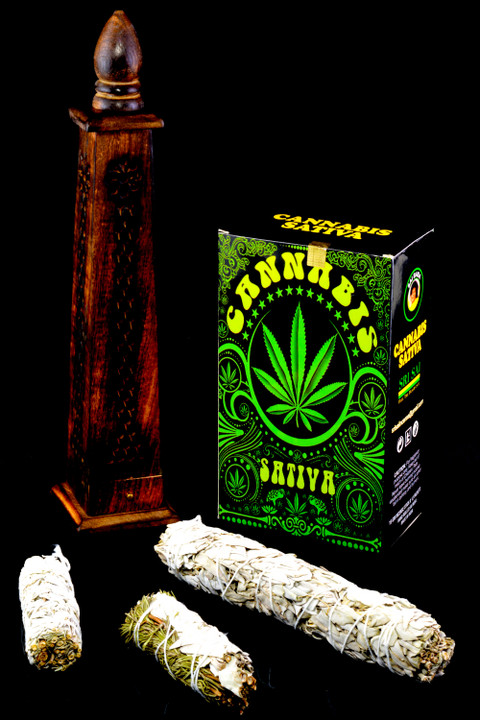Burnin’ For You: Wholesale Incense and Sage
We’ve all asked ourselves at one point or another “What is that awful smell?”, and while we may struggle to find the source to The Stink™, the solution to it may be as simple as lighting a fragrant stick on fire and forgetting about it.
Believed to have originated somewhere in the Middle East, incense was primarily used in religious ceremonies within Egypt and was manufactured from imported aromatic trees, much like it is today. However, incense wasn’t truly used for leisure until an innovative Buddhist priest from China, named Ganjin, arrived in Japan and spread his knowledge of medicinal incense, known as Takimono (a variety of nerikoh) to the general population. From this came widespread use of fragrances outside of rituals and medical practices and even led to a fragrance competition called Takimonoawase between the 8th and 12th centuries. The fun was not limited to nobility, as anyone could create their own fragrances from scents including, but not limited to, cinnamon, frankincense, musk, myrrh, patchouli, and sandalwood. The element that allows this to smoke is typically charcoal or wood powders, if it is a combustible, direct-burning incense, as something has to light the fire, while indirect-burning, non-combustible incense sits upon a heat source such a warm plate and diffuses the aroma.
The variety of bulk incense for resale we carry, Nag Champa, is known as agarbatti or joss sticks, and involves hand or machine rolling or molding an incense paste around a bamboo stick to effectively absorb the aromas, a method that originated in India, and is still widely utilized today. An alternate method of creating incense sticks is dipping or hand-dipping a standard, direct-burning incense stick into a fragrance or essential oil, allowing the combustible “incense blank” to successfully soak up the oils, such as with our Chakra incense sticks. Other forms of incense creation include spraying the sticks with perfume or stick machines that coat the stick with the fragrance of the creator’s choice. Enough with creation, though, as it is only partially relevant to the really fun part: setting that stick on fire! Let’s break it down now, ya’ll.
Step 1: Light Your Fire
This can be done as you might expect, with a match, a lighter, a piece of hemp wick, a camp fire, a fire place...though this may not be an area to be creative in. You’ll want to only gently light the tip, so that it doesn’t burn out of control, which is typically easiest to do when the stick is angled upwards.
Step 2: Set Out Your Fire
Extinguish the flame it took you so long to create by gently blowing it out, but not completely. The stick should then glow and produce the scent you chose. If the entire incense holder starts burning, then you’ve done something wrong and should *probably* call 9-1-1.
As you can see, this process is pretty complicated, but we’ve got you covered. If you don’t intend to burn the entire stick of incense, then you can cut the tip off with scissors or remove the stick from your holder an extinguish it against a preferably non-flammable surface, unless you’re an aspiring pyromaniac or arsonist.
We wouldn’t want to be incense-itive, so we’ll also mention incense’s sister: sage. Also known as smudge, burning sage originated as a spiritual ritual and is believed to have purifying and cleansing properties due to its’ antimicrobial properties. The process for burning sage is similar to that of burning incense, where you light the bundle and put out the fire just enough to where it still smolders but isn’t engulfed in flames. Carrying some sort of bowl or other ash receptacle is recommended to reduce the incidence of fire. The smoke released from smudge is thicker than that of incense, so it’s optimal to leave a window open for proper ventilation, to decrease the chances of setting off a fire alarm and to exercise immense caution to not breathe the smoke in directly. To quench the simmering of the sage bundle, simply dip the end into a bowl of sand or ash and ensure there aren’t any active embers. While it is possible to extinguish both incense and sage with water, it is preferable to extinguish it with a dry/quenching method to retain the aroma of both.
Your customers may be looking to get in touch with their spooky or spiritual side or maybe they’re just looking to mask the unpleasant scent of cigarette smoke with the pleasant scent of incense smoke. Whatever their intention, we have the selection of wholesale incense and bulk sage to suit the fancy, so browse them here.
Product spotlights & merchandising ideas
Mushroom Mush-Haves for Any Smoke Shop
The Fun-Gi Takeover: Mushroom-Themed Smoking Accessories for Your Shop Mushrooms are having a major...
Collect Them All: Hemper Glass Families That Turn Fans into Regulars
Level Up Your Glass Case: Hemper Theme Drops for Serious Fun Margins If your water pipe case looks...
Universal Attraction: NWTN Home's Law of Physical Sales
NWTN Home: Glass That Feels Like Home (and Sells) Born from over a decade of design work in the tab...
Love at First Lookah: Devices That Turn Heads (and Profit)
Lookah has been designing crowd-pleasing head-shop staples for more than 15 years, evolving from its...
Cabin Fever: The Alpine Collection Trailblazers That Spruce Up Any Case
A Closer Look at MJ Arsenal’s Alpine Collection Lace up your merch boots—MJ Arsenal’s Alpine Colle...
So Fresh, So Clean: Formula 420 & Formula 710 Cleaners for Every Sticky Situation
A Quick Dip into Formula 420 History Before “one-minute clean” became the counter catchphrase, Formu...







